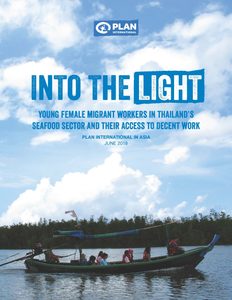Into the Light
Young Female Migrant Workers in Thailand's Seafood Sector and Their Access to Decent Work
This study sheds light on this often-ignored population of migrants, focusing on a group of young Cambodian migrant women in Thailand working in the seafood sector.

In the labour market, gender-based discrimination, harmful traditional practices, restricted opportunities, and the lower value placed on women’s economic contributions often result in higher rates of unemployment among young women. Despite the poor work conditions, young Cambodians continue to migrate to work in the Thai fishing sector.
Current migration trends are evidence of unprecedented human mobility around the globe. Nearly 52% of migrant adolescents and youth worldwide lived in developing countries, the largest number (36%) residing in Asia. The proportion of women among the young migrants in developing countries is significant at nearly 45%. Despite the high proportional number of young female migrants, they continue to face unique and persistent challenges when navigating the labour market and realising their aspirations.
The fishing industry in Thailand is a sector that is heavily reliant on migrant labour. Fisheries exports from Thailand were pegged at USD 6.6 billion in 2014. The fishing and seafood industry employed more than 600,000 people in 2017, of which 302,000 were registered migrant workers. Therefore, migrant workers are an important resource for the Thai fisheries sector.
At the same time, studies have reported the harsh working conditions in the fisheries sector for migrants in Thailand. Despite the poor work conditions, young Cambodians continue to migrate to work in the Thai fishing sector.
In order to ensure that youth within this sector do not face a dead-end when it comes to their career and overall life, it is important to understand the existing working and living conditions and understand as well as their aspirations.
Young Cambodian women, in particular, are struggling to expand their life choices. Labour force participation rate for women aged 15-24 is about 74% in Cambodia. There are no clear figures for young Cambodian women working in Thailand. Opportunities for young women migrants within the fisheries sector in both countries need to be expanded in order to support their aspirations for a better future.
Download options
Full Report
6 mb
Skills and work, Livelihoods, Migrant and displaced children


